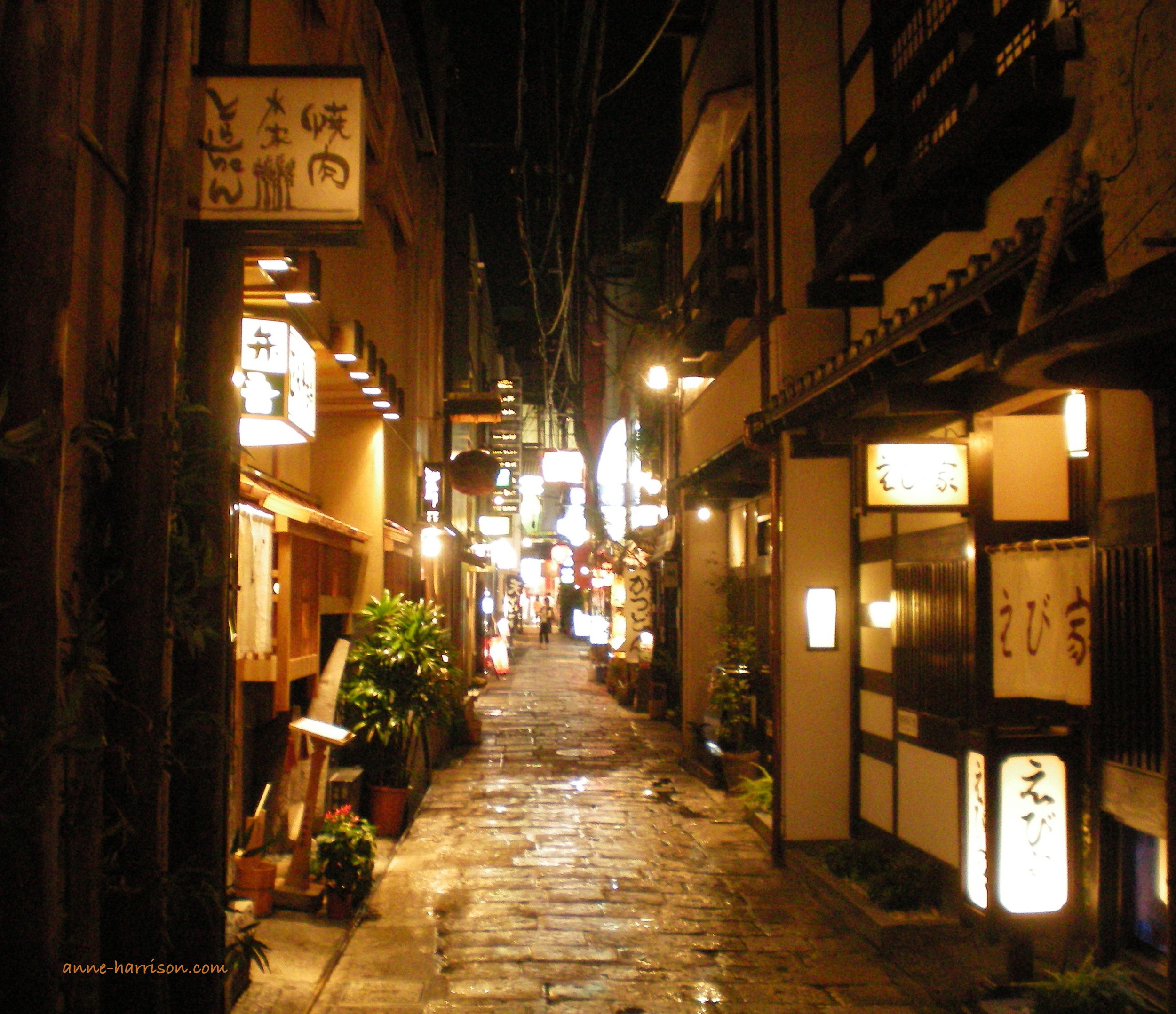Eating Japan.
A shout stopped me halfway along the street. Behind us, on his bike, came the concierge from the ryokan; he’d pedalled after us, worried we might get lost.
With family in tow, I was following his suggestions for breakfast. Considering the language barrier, he’d given remarkably precise directions, complete with a hand-drawn map – yet still he worried we’d lose our way, and kept weaving his way behind us until we reached the restaurant safely. Then, with a smile and wave, he rode away, if not quite into the sunset, at least to be swallowed by the crowds.
Along with the map, the concierge had also written some suggestions – in Japanese — which I handed to the waitress. With a bow she led the us over to the ubiquitous vending machine and pressed a selection of buttons. Out came not a meal, but brass-coloured tokens. The waitress ushered us to our chairs with another bow, then disappeared into the kitchen with the tokens. Soon the meals appeared, steaming bowls with variations of noodles and vegetables — and mine with a raw egg cracked on top.
I always seemed to get the meal with the raw egg — but then, there is little I won’t eat, at least once.
A great place to shop © A. Harrison
Breakfast was a different affair when staying in Koyasan, Japan’s Holy mountain. I woke before the dawn. My room looked over a tiny courtyard of pebbles and an artistically pruned azalea, now in full bloom. A small stone basin, filled with running water, stood in one corner. At this hour, however, I could see only a hint of colour from the azalea, for the world was still dark.
Dawn came as I knelt in an ancient temple watched the monks perform their ceremony. Afterwards, I enjoyed a traditional Japanese breakfast of miso and rice, grilled fish, nori, tofu, pickled vegetables and green tea.
Eating in Japan can prove expensive. Wandering through a supermarket, I though the meat the same price as at home — until I realised it was sold not by the kilogram but rather by the 100 gm. Yet there are ways to eat well, and cheaply.
Japan is a country of vending machines. Anything can be bought from these machines, from flavoured instant noodles to freshly prepared sushi and Benito boxes. Stand in a busy train station, and you’ll be amazed at the number of commuters who buy their meals from these machines.
Coffee (of a sort) also comes from a vending machine. With the labels all in Japanese, only the colours of the button give any clue to the dozen or so choices — red for hot, blue for cold. Ice cream seemed a better choice — until I ended up sampling the unique flavour of the green tea ice-cream. It proved remarkably refreshing. (Once again, the labels were in Japanese, but at least these came with a few drawings.) Summer in Japan can be very hot.
Some of the vending machine coffee on offer © A. Harrison
Sushi train offers another look and choose option. The variety and freshness are staggering, and each piece a work of art in itself. I didn’t recognise half of what went round on the conveyor belt, and only wished I have could sample them all. Little taps of hot water were each station, letting me make and top up my own cup of green tea.
Local corner stores also sell fresh meals. I sent my daughter down to buy some sushi. She made her selection, and dutifully handed her coin purse over at the counter. After taking out the correct money, the assistant packaged up the meals and handed both sushi and wallet back to my daughter.
Window displays are common — and a boon to those like me who can’t read Japanese. Many of these restaurants are relatively cheap, or at least have cheaper options. Noodle restaurants are another alternative, delivering large bowls of steaming broth, udon noodles with a variety of additions. Once again, the choice is made from the displays in the window. In the old quarter of Nara I stumbled across a shop specialising in these displays. Exquisitely detailed, they looked as delicious as a real meal — and far more expensive. The second-hand kimonos in the shop next door proved far more affordable.
Restaurants in the back streets of Osaka, along with a friendly welcome © A. Harrison
Yet perhaps the cheapest but most interesting meals I had in Japan were those I cooked myself.
Japan has an extensive network of youth hostels, and staying in one comes with all the facilities of a communal kitchen. A small supermarket was a few minutes walk from my abode in Kyoto. Two aisles alone were dedicated to rice, ranging from small sachets to huge sacks not even a sumo could lift.
Everything was exquisitely packaged. Inspired by the works of Haruki Murakami I’d hoped to try some curry, yet the pictures on the various tins and sachets gave no clue, so I chose those I thought prettiest. How else was I to choose? From amongst the fish I picked some I did not recognise, but were about the size of a small trout.
Back at the youth hostel, I was one of the few cooking. Most, it seemed, preferred the ease of instant noodles; better for the budget, perhaps, but not as much fun. After a day of visiting temples, some pan-fried fish, rice, and lightly steamed greens seemed the appropriate thing to eat.
A classic dish of beef and noodles © A. Harrison
Enjoy my writing? Please subscribe here to follow my blog. Or perhaps you’d like to buy me a coffee? (Or a pony?)
If you like my photos please click either here or on the link in my header to buy (or simply browse) my photos. Or else, please click here to buy either my poetry or novel ebooks. I even have a YouTube channel. Thank you!
Some of my other posts you might enjoy:












Dante began writing The Divine Comedy while exiled from his beloved Florence. The pain of banishment weaves through his work. The poet never returned to his native city; even the tomb built for him in 1829 in Santa Croce remains empty. Yet were Dante to return to Florence today, much of the city would be familiar to him.